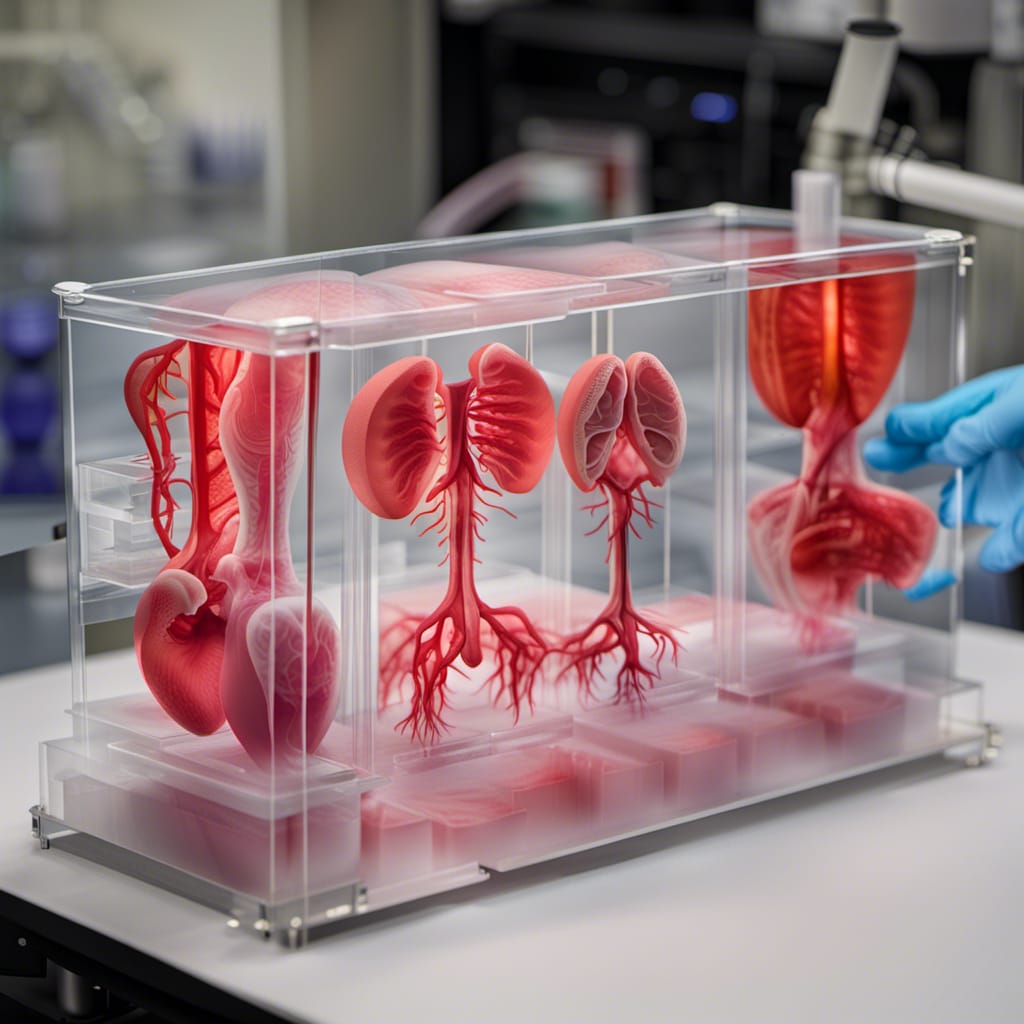3D Printed Organs: Revolutionizing Healthcare with Bioengineered Solution
Updated April 1, 2024
Introduction: Unlocking the Future of Transplant Medicine
The concept of 3D-printed organs is transitioning from science fiction to tangible reality, poised to redefine healthcare. This article explores this groundbreaking technology’s intricate process, benefits, challenges, and potential future implications.
The Art and Science of 3D Organ Printing:
Creating 3D-printed organs involves a complex, multi-step process. It starts with generating a precise 3D image of the target organ using advanced imaging techniques like CT or MRI scans. This image is then converted into a digital blueprint, guiding the 3D printer. Armed with specialized bio-ink containing living cells, the printer meticulously constructs the organ layer by layer, resulting in a fully functional transplantable organ.
Unlocking Unprecedented Advantages:
The advent of 3D-printed organs offers two significant advantages. Firstly, it addresses the chronic shortage of organ donors, a global healthcare challenge. By eliminating donor reliance, this technology could save countless lives. Secondly, 3D-printed organs allow for customization, reducing the risk of organ rejection and enhancing transplant success rates.
Navigating the Challenges:
While promising, several challenges accompany the journey towards widespread adoption. A critical hurdle is creating intricate blood vessels within printed organs, vital for functionality. Scientists are making strides but continue to face obstacles. Additionally, the current cost and time-intensive nature of the process pose substantial barriers to accessibility.
A New Dawn in Healthcare:
Despite challenges, the future of 3D-printed organs is promising. Rapid technological advancements could soon make this approach a standard medical practice, effectively solving organ donor shortages. This technology may also revolutionize medical procedures, making them less invasive and more effective.
Regulatory and Ethical Considerations:
The successful implementation of 3D-printed organs demands careful regulatory and ethical frameworks. Ensuring the safety, efficacy, and accessibility of these organs is paramount. Regulatory bodies are actively working to establish guidelines addressing quality control, patient safety, and equitable distribution concerns.
The Emergence of Bioprinting in Healthcare: Pioneering Personalized Medicine
Recent advancements in bioprinting have significantly expanded the possibilities for medical procedures, offering a promising future in creating living tissues and organs. This technology holds the potential to revolutionize organ transplants and enhance personalized medicine by tailoring treatments to individual needs.
The Art and Science of Bioprinting
Bioprinting employs 3D printing techniques to construct living tissues and organs by layering bio-inks made of cells. This process begins with creating a detailed 3D model based on patient-specific medical imaging. Innovations in this field have led to the development of functional prototypes, such as an artificial pancreas, showcasing the potential to address complex medical challenges.
The primary benefits of bioprinting include the ability to produce custom-made organs tailored to the patient’s anatomy, significantly reducing the risk of rejection and increasing the success rates of transplants. Beyond organ replacement, bioprinting extends to tissue engineering for repairing or replacing damaged cartilage, skin, and other tissues. It also accelerates drug testing and research by providing more accurate tissue models that reflect human responses better than animal tests.
Challenges and Ethical Considerations
Despite its potential, bioprinting faces several challenges. The sourcing of suitable cells and the intricate process of creating functional blood vessels within tissues remain significant hurdles. The technology’s current cost and the time required for printing complex organs also pose barriers to widespread adoption. Ethically, bioprinting prompts considerations regarding organ ownership, distribution, and potential exploitation, necessitating robust regulatory frameworks to ensure ethical practices.
Visionary Insights from Leading Experts
Jennifer Lewis, a professor at Harvard University’s Wyss Institute for Biologically Inspired Engineering, suggests that fully functioning bioprinted organs suitable for implantation may still be a decade away, emphasizing advancements’ rapid but complex nature in this field. Similarly, Anthony Atala, a pioneer in regenerative medicine, advises caution in predictions, highlighting the multifaceted challenges of bioprinting, from manufacturing to regulatory hurdles imposed by entities like the US Food and Drug Administration.
Looking forward, the bioprinting of entire limbs and more complex organ systems could drastically change the field of prosthetics and organ transplants. The evolution towards complete personalization in medicine could lead to significantly more effective treatments, with fewer side effects, thereby improving patient outcomes and reducing overall healthcare costs.
Conclusion: The Transformative Impact of 3D Bioprinting in Modern Medicine
3D bioprinting represents a monumental leap in medical technology, offering groundbreaking solutions to longstanding challenges in healthcare. This innovative approach promises to alleviate the critical shortage of transplantable organs and paves the way for personalized medical treatments tailored to individual patient needs.
Recent advancements have enabled the creation of organoids, which, while miniature and not fully functional, closely mimic the structure and function of full-sized organs. These organoids serve as invaluable models for drug testing and disease study, significantly enhancing the precision and effectiveness of medical research and pharmaceutical development.
Leading experts in the field, such as Dr. Shaochen Chen from the University of California, San Diego, emphasize the potential of bioprinting to revolutionize tissue engineering by improving the mechanical properties of bio-inks. These advancements enhance the survival and functionality of printed tissues, bringing us closer to the reality of fully functional bioprinted organs.
Dr Nina Tandon, CEO of EpiBone and a pioneer in bioprinting highlights the transformative potential of integrating patient-specific cells into bioprinted tissues. This personalized approach mitigates the risk of immune rejection and significantly improves the outcomes of transplants and other medical interventions.
Overcoming Challenges
Despite these promising developments, bioprinting faces several technical and ethical challenges. The complexity of replicating the intricate network of blood vessels necessary to sustain organ tissues remains a significant technical hurdle. Ethically, the technology prompts discussions about organ ownership, distribution, and the potential for unequal access to these life-saving resources.
The trajectory of bioprinting technology suggests a future where the bioprinting of complete organs and even limbs could become routine, fundamentally changing the landscape of medicine and healthcare. The ongoing research and development in creating more complex tissue structures and integrating them seamlessly with human physiology pave the way for clinical applications that could save millions of lives.
As we stand on the brink of these exciting advancements, we must continue to navigate the ethical landscapes and regulatory frameworks that will shape the use of this technology. By fostering collaboration between researchers, clinicians, and policymakers, we can harness the full potential of 3D bioprinting to create a future where personalized medicine is not just a possibility but a reality.
In conclusion, 3D bioprinting is set to transform healthcare by providing solutions to organ shortage crises, enhancing the efficacy of treatments, and personalizing medical care to unprecedented levels. The commitment to overcoming its challenges and the continued evolution of its technologies will undoubtedly lead to significant improvements in patient outcomes and the overall effectiveness of healthcare systems worldwide.
Beyond the Ordinary: Fascinating Articles That Stand Out

How much money do i need to invest to make $4,000 a month?

Warren Buffett Stock Picks: Unveiling a Simple Strategy for Better Returns

How Do You Win the Stock Market Game? Effective Strategies

Amazon Stock Direct Purchase Plan: A Comprehensive Guide

Bullish RSI Divergence: A Key To Unlocking Market Opportunities

Types of Trend Lines: Their Power and Limitations

Best Silver ETFs: Shining Bright in Your Investment Portfolio

Black Monday 1987: Turning Crashes into Opportunities

Technical Analysis of Trends: Cracking the code

Golden Gains: The Key Advantages of Investing in Gold

A Sophisticated Approach: Do Bonds Increase Returns When the Stock Market Crashes?

Emotional Manipulation Tactics: The Dominant Force on Wall Street

Mastering Your Finances: Why You Need to Learn How to Manage Your Money with Grace

Stock Market Forecast Next 10 Years: Feasible or Not?

Why is the US Dollar Not Backed by Gold? Unveiling its Deadly Impact
IPI Stock Price: Ascending Star or Descending Dagger?



